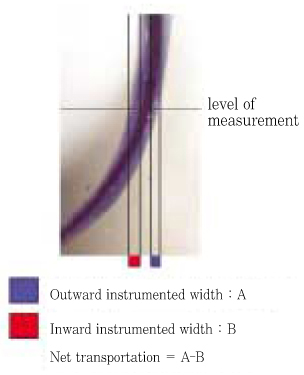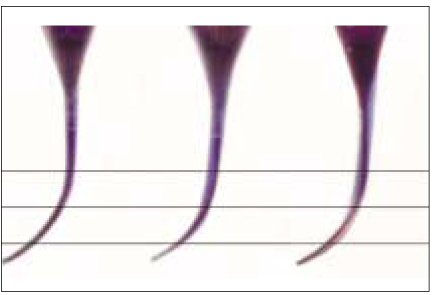Relative efficacy of three Ni-Ti file systems used by undergraduates
- Affiliations
-
- 1Department of Conservative Dentistry, College of Dentistry, Pusan National University, Korea. bhur@pusan.ac.kr
- KMID: 1986995
- DOI: http://doi.org/10.5395/JKACD.2005.30.1.038
Abstract
- The purpose of this study was to compare and evaluate the shaping ability of the three different Ni-Ti file systems used by undergraduate students. Fifty undergraduate students prepared 150 simulated curved root canals in resin blocks with three Ni-Ti file systems - ProFile(R) (PF), Manual ProTaper(R) (MPT), Rotary ProTape(R) (RPT). Every student prepared 3 simulated root canals with each system respectively. After root canal preparation, the Ni-Ti files were evaluated for distortion or breakage. Assessments were made according to the presence of various types of canal aberrations. The pre- and post-instrumented canal images were attained and superimposed. The instrumented root canal width were measured and calculated for the net transportation (deviation) and the centering ratio. Under the condition of this study, both ProTaper(R) systems allowed significantly more removal of root canal wall than the ProFile(R) system. In the important other aspects such as the centering ratio, there was no significant differences between the systems. Novice dental students were able to prepare curved root canals with any kinds of Ni-Ti file systems with little aberration and great conservation of tooth structure. Students want to learn effective methods and at the same time simple rotary procedures. The rotary ProTaper(R) systems were one of the most compatible to these students from the point of view of cutting ability. The ProFile(R) system was also compatible in safe and gentle shaping.
Figure
Cited by 6 articles
-
Comparison of shaping ability between various hybrid instrumentation methods with ProTaper
Eun-Sook Hong, Jeong-Kil Park, Bock Hur, Hyeon-Cheol Kim
J Korean Acad Conserv Dent. 2006;31(1):11-19. doi: 10.5395/JKACD.2006.31.1.011.Comparison of shaping ability of rotary Ni-Ti file systems used by undergraduates
Mun-Seong Kang, Hyeon-Cheol Kim, Bock Hur, Jeong-Kil Park
J Korean Acad Conserv Dent. 2006;31(1):1-10. doi: 10.5395/JKACD.2006.31.1.001.Comparison of shaping ability between single length technique and crown-down technique using Mtwo rotary file
Yoo-Kyoung Lim, Jeong-Kil Park, Bock Hur, Hyeon-Cheol Kim
J Korean Acad Conserv Dent. 2007;32(4):385-396. doi: 10.5395/JKACD.2007.32.4.385.Comparison of shaping ability using various Nickel-Titanium rotary files and hybrid technique
Jung-Won Kim, Jeong-Kil Park, Bock Hur, Hyeon-Cheol Kim
J Korean Acad Conserv Dent. 2007;32(6):530-541. doi: 10.5395/JKACD.2007.32.6.530.Stress distribution of three NiTi rotary files under bending and torsional conditions using 3-dimensional finite element analysis
Tae-Oh Kim, Chan-Joo Lee, Byung-Min Kim, Jeong-Kil Park, Bock Hur, Hyeon-Cheol Kim
J Korean Acad Conserv Dent. 2008;33(4):323-331. doi: 10.5395/JKACD.2008.33.4.323.Prognostic factors influencing clinical outcome of nonsurgical endodontic treatment
Seonah Kim
J Korean Acad Conserv Dent. 2010;35(6):436-444. doi: 10.5395/JKACD.2010.35.6.436.
Reference
-
1. Deplazes P, Peters O, Barbakow F. Comparing apical preparations of root canals shaped by nickel-titanium rotary instruments and nickel-titanium hand instruments. J Endod. 2001. 27(3):196–202.
Article2. Esposito PT, Cunningham CJ. A comparison of canal preparation with nickel-titanium and stainless steel instruments. J Endod. 1995. 21(4):173–176.
Article3. Schafer E, Schulz-Bongert U, Tulus G. Comparison of hand stainless steel and nickel titanium rotary instrumentation: a clinical study. J Endod. 2004. 30(6):432–435.
Article4. Coleman CL, Svec TA. Analysis of Ni-Ti versus stainless steel instrumentation in resin simulated canals. J Endod. 1997. 23(4):232–235.
Article5. Garip Y, Gunday M. The use of computed tomography when comparing nickel-titanium and stainless steel files during preparation of simulated curved canals. Int Endod J. 2001. 34(6):452–457.
Article6. Schafer E. Shaping ability of Hero 642 rotary nickel-titanium instruments and stainless steel hand K-Flexofiles in simulated curved root canals. Oral Surg Oral Med Oral Pathol Oral Radiol Endod. 2001. 92(2):215–220.
Article7. Hata G, Uemura M, Kato AS, Imura N, Novo NF, Toda T. A comparison of shaping ability using ProFile, GT file, and Flex-R endodontic instruments in simulated canals. J Endod. 2002. 28(4):316–321.
Article8. Ankrum MT, Hartwell GR, Truitt JE. K3 Endo, ProTaper, and ProFile systems: breakage and distortion in severely curved roots of molars. J Endod. 2004. 30(4):234–237.
Article9. Bergmans L, Van Cleynenbreugel J, Beullens M, Wevers M, Van Meerbeek B, Lambrechts P. Progressive versus constant tapered shaft design using NiTi rotary instruments. Int Endod J. 2003. 36(4):288–295.
Article10. Clauder T, Baumann MA. ProTaper NT system. Dent Clin North Am. 2004. 48(1):87–111.
Article11. Baumann MA, Roth A. Effect of experience on quality of canal preparation with rotary nickel-titanium files. Oral Surg Oral Med Oral Pathol Oral Radiol Endod. 1999. 88(6):714–718.
Article12. Gluskin AH, Brown DC, Buchanan LS. A reconstructed computerized tomographic comparison of Ni-Ti rotary GT files versus traditional instruments in canals shaped by novice operators. Int Endod J. 2001. 34(6):476–484.
Article13. Sonntag D, Guntermann A, Kim SK, Stachniss V. Root canal shaping with manual stainless steel files and rotary Ni-Ti files performed by students. Int Endod J. 2003. 36(4):246–255.
Article14. Sonntag D, Delschen S, Stachniss V. Root-canal shaping with manual and rotary Ni-Ti files performed by students. Int Endod J. 2003. 36(11):715–723.
Article15. Hanni S, Schonenberger K, Peters OA, Barbakow F. Teaching an engine-driven preparation technique to undergraduates: initial observations. Int Endod J. 2003. 36(7):476–482.
Article16. Qualtrough AJ, Dummer PM. Undergraduate endodontic teaching in the United Kingdom: an update. Int Endod J. 1997. 30(4):234–239.
Article17. Qualtrough AJ, Whitworth JM, Dummer PM. Preclinical endodontology: an international comparison. Int Endod J. 1999. 32(5):406–414.
Article18. Calhoun G, Montgomery S. The effects of four instrumentation techniques on root canal shape. J Endod. 1988. 14(6):273–277.
Article19. Kosa DA, Marshall G, Baumgartner JC. An analysis of canal centering using mechanical instrumentation techniques. J Endod. 1999. 25(6):441–445.
Article20. Parashos P, Messer HH. Questionnaire survey on the use of rotary nickel-titanium endodontic instruments by Australian dentists. Int Endod J. 2004. 37(4):249–259.
Article21. Yared G, Bou Dagher F, Kulkarni K. Influence of torque control motors and the operator's proficiency on ProTaper failures. Oral Surg Oral Med Oral Pathol Oral Radiol Endod. 2003. 96(2):229–233.
Article22. Szep S, Gerhardt T, Leitzbach C, Luder W, Heidemann D. Preparation of severely curved simulated root canals using engine-driven rotary and conventional hand instruments. Clin Oral Investig. 2001. 5(1):17–25.
Article23. Yared GM, Dagher FE, Machtou P, Kulkarni GK. Influence of rotational speed, torque and operator proficiency on failure of Greater Taper files. Int Endod J. 2002. 35(1):7–12.
Article24. Calberson FL, Deroose CA, Hommez GM, De Moor RJ. Shaping ability of ProTaper nickel-titanium files in simulated resin root canals. Int Endod J. 2004. 37(9):613–623.
Article25. Yun HH, Kim SK. A comparison of the shaping abilities of 4 nickel-titanium rotary instruments in simulated root canals. Oral Surg Oral Med Oral Pathol Oral Radiol Endod. 2003. 95(2):228–233.
Article26. Schafer E, Vlassis M. Comparative investigation of two rotary nickel-titanium instruments: ProTaper versus RaCe. Part 1. Shaping ability in simulated curved canals. Int Endod J. 2004. 37(4):229–238.
Article27. Iqbal MK, Firic S, Tulcan J, Karabucak B, Kim S. Comparison of apical transportation between ProFile and ProTaper NiTi rotary instruments. Int Endod J. 2004. 37(6):359–364.
Article28. Slaus G, Bottenberg P. A survey of endodontic practice amongst Flemish dentists. Int Endod J. 2002. 35(9):759–767.
Article29. European Society of Endodontology. Undergraduate curriculum guidelines for endodontology. Int Endod J. 2001. 34(8):574–580.30. Berutti E, Chiandussi G, Gaviglio I, Ibba A. Comparative analysis of torsional and bending stresses in two mathematical models of nickel-titanium rotary instruments: ProTaper versus ProFile. J Endod. 2003. 29(1):15–19.
Article
- Full Text Links
- Actions
-
Cited
- CITED
-
- Close
- Share
- Similar articles
-
- Comparison of shaping ability of rotary Ni-Ti file systems used by undergraduates
- Shaping ability of Ni-Ti rotary files in combination with GT rotary Ni-Ti file
- Comparison of screw-in effect of three NiTi file systems used by undergraduates
- The effect of NaOCl treatment and sterilization procedures on the corrosion of endodontic files
- The effect of different flute design and torque-controlled motor on the shaping ability of simulated resin root canals



